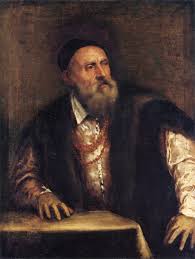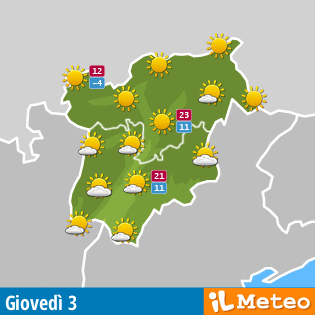Titian
The most Famous Citizen of Pieve di Cadore
 |
| Italian |

 |
Titian (Tiziano) was born in Pieve di Cadore, in a family not noble but with a certain social status. Always scholars of his biography discuss about his date of birth, at that time there were no registers. It is believed that Titian was born between 1485 and 1490. Certainly we know that he died in Venice August 27, 1576 now elderly, had spent the eighties and the plague in the city was claiming more victims. |
He arrived in Venice still very young and went to learn the craft as a painter at the workshop of Gentile and Giovanni Bellini. Learned to distinguish his talents and went in short, between 1508 and 1509, to the shop of another master of art, becoming, as well as student, also worker with Giorgione, with whom created the Fondaco of the Germans. The artist worked hard throughout his long life, which sometimes was not easy. But it was always an extrovert and creative. Already in the more youthful works Titian had learned how to rework the style coming from the center of Italy, monumental and dynamic, with the traditional Venetian colouring.
He needed only one year to establish his reputation. The came of the first orders as the altarpiece of San Marco and Santa Maria della Salute, in 1511 he frescoed the Scuola del Santo in Padua. In these years he accepted many works by the nobles, who commissioned him often works with secular subjects. In 1533 he obtained the appointment of the Republic of Venice painter who was followed by an annuity given only to the best painters of the Venetian Republic. In the first period he painted works such as Noli Me Tangere, half female figures such as Flora. In this period he innovated Venetian art with works of intense expressive realism, as evidenced by this portrait of Ariosto or woodcuts of Sacred Love and Profane Love and Assumption.
But even before the artist began working for various courts scattered throughout Italy. He worked in Ferrara, Mantua, Urbino and after 1540 came to Rome. Here he worked for Pope Paul III and his family, he remained there until 1546. But also worked for the crown of the Habsburgs. At Urbino painted mythological scenes like Bacchanal, the Venus of Urbino and yet Charles V, the Man of the Glove, The Beautiful and also a realistic tone altarpiece: the Pala of Pesaro. The stay in Rome was a turning point for Titian. He introduced a new type of representation highly dramatic and emotional works as Ecce Homo and Paul III with Nephews Alexander and Octavos. Intense was the production of works of erotic and mythological works such as Venus with Organist, Cupid and Puppy and Danae.
The old Titian
In Venice again he produced works of a religious nature such as The Martyrdom of St. Lorenzo and one of his last masterpiece Annunciation, Tarquin and Lucretia or even Coronation of Thorns. The innovative feature of this artist consisted of pushing to extremes in the intense use of colour painting, doing almost the colour so that it would prevail on the forms and subjects Brush strokes restless. Titian is recognized as the starter of a new language that influenced painters such as Rembrandt, Rubens, Velazquez and others, even in later times to his. Nowdays in Pieve di Cadore it's possible to vistit the house where the famous painter was born.
